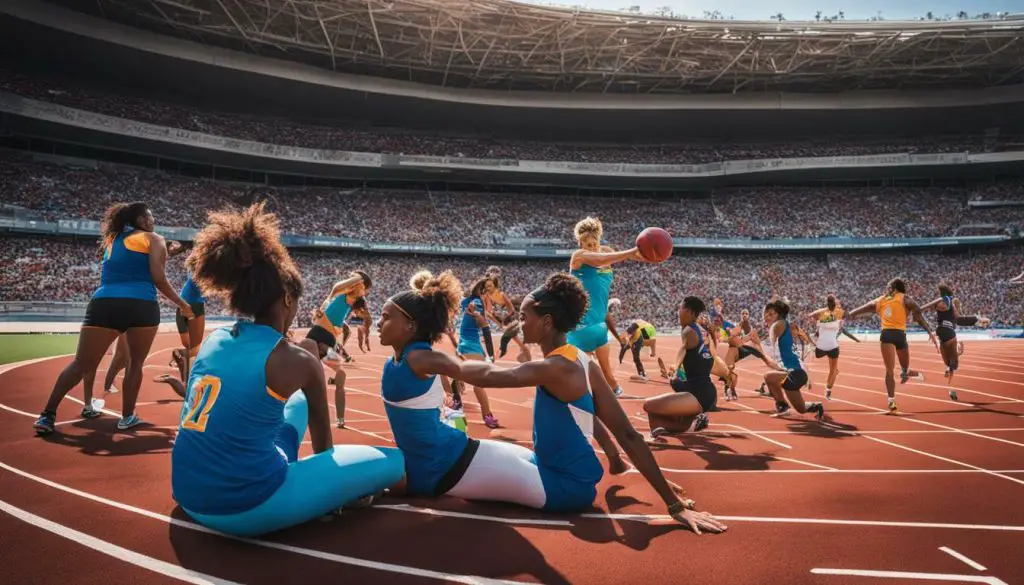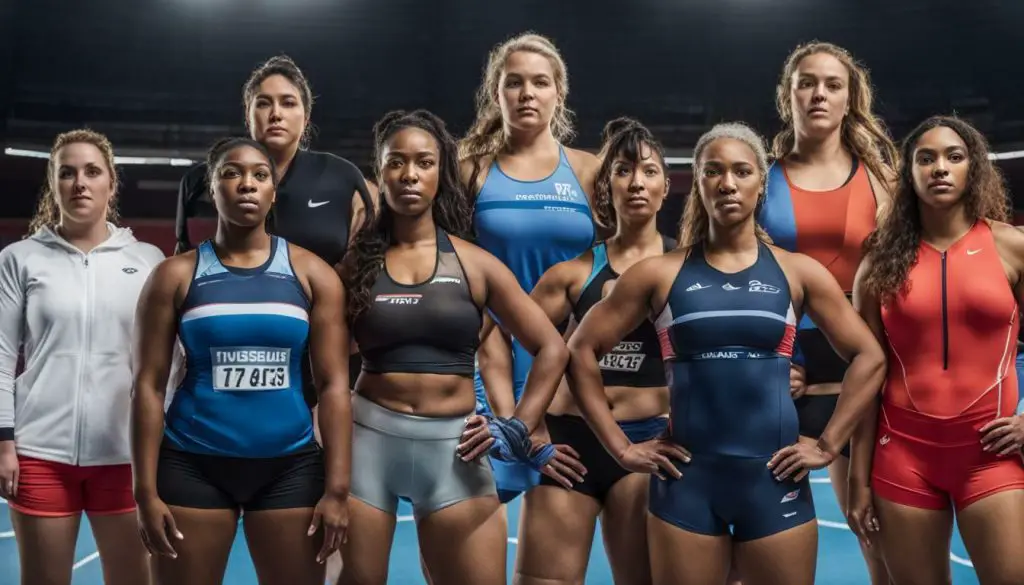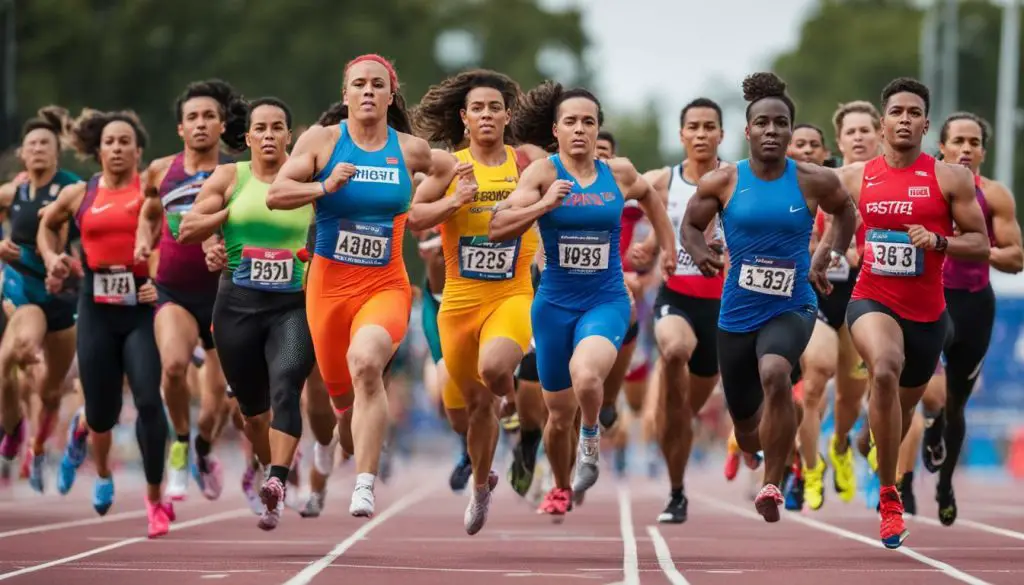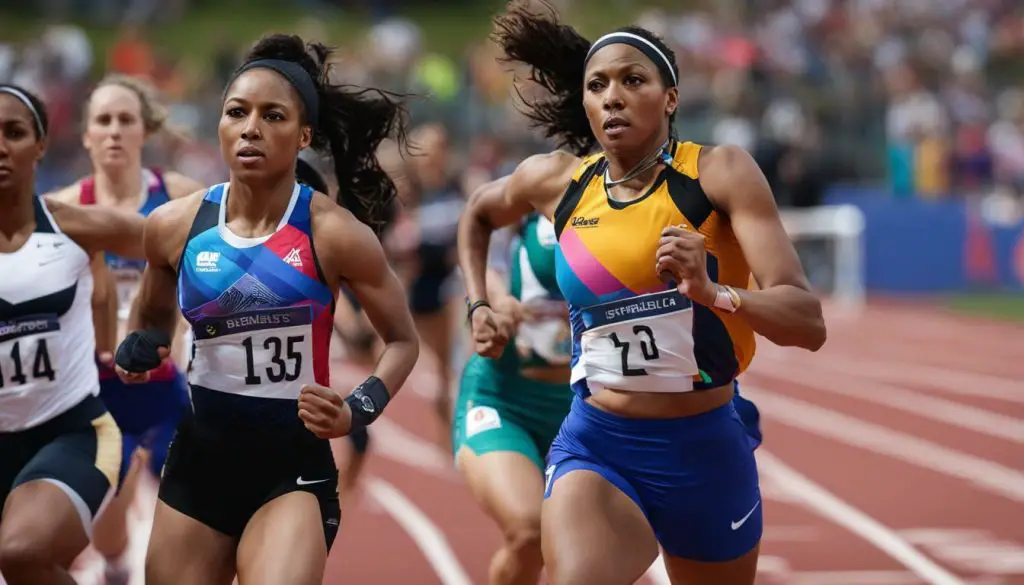The participation of transgender athletes in women’s sports has sparked a contentious debate, raising questions about fairness, advantage, and inclusivity. Critics argue that allowing transgender athletes to compete may result in an unfair advantage due to physiological differences. These concerns center around the concept of preserving fairness in competitive sports, with opponents highlighting the potential impact of gender-specific divisions and the complexities of determining athletic eligibility based on gender identity versus biological sex.
On the other hand, supporters of transgender inclusion maintain that gender identity should be the determining factor for participation in sports, emphasizing the importance of inclusivity over biological differences. They argue that transgender women should have the same opportunities as cisgender women and that excluding them from competition would be discriminatory.
The debate further intensifies when considering the impact of hormone therapy on transgender athletes’ athletic performance. Studies suggest that while hormone therapy can mitigate some physical advantages, it may not fully erase them. These findings contribute to ongoing discussions about the competitive advantage transgender athletes may have in women’s sports.
Sports organizations and governing bodies have also grappled with developing fair policies for transgender athlete participation. The varying approaches across different sports add complexity to the issue, as each sport must consider its unique dynamics and strive to strike a balance between inclusivity and maintaining a level playing field.
Recent state legislation has further complicated the landscape, with some states implementing restrictions on transgender athletes’ participation in women’s sports. The motivations behind these laws are debated, with advocates citing concerns over fairness and opponents arguing against discrimination.
Ultimately, the central question at the heart of the transgender athlete debate revolves around defining fairness in women’s sports. Striking a balance between inclusivity and maintaining a level playing field is a complex task that requires ongoing dialogue and thoughtful consideration of the challenges surrounding transgender athlete inclusion.
Critics argue that allowing transgender athletes to compete in women’s sports undermines fairness and creates an uneven playing field. They believe that individuals assigned male at birth have inherent physical advantages, such as larger muscle mass and denser bones, that cannot be fully reversed through hormone therapy. These biological differences, they contend, provide transgender women with a significant competitive advantage, posing a threat to the integrity of women’s sports.
“When we talk about fairness in sports, we must acknowledge that there are fundamental physiological differences between males and females,” says sports analyst Sarah Johnson. “Allowing transgender women to compete against cisgender women may compromise the principles of fair competition and erode the opportunities for female athletes to excel in their own categories.”
The concern lies in maintaining a level playing field and preserving the integrity of women’s sports. Critics argue that gender-specific divisions are necessary to ensure fair competition, as they create a space where athletes with similar physical attributes can compete against each other. They advocate for policies that consider biological sex as the primary determinant for participation in women’s sports, arguing that this approach better safeguards the principles of fairness and prevents the potential for a dominant advantage.

| Arguments Against Transgender Athlete Inclusion | Counterarguments |
|---|---|
| Transgender women may have residual physical advantages, even with hormone therapy. | Studies have shown that hormone therapy can significantly mitigate these advantages. |
| Allowing transgender women to compete may hinder opportunities for cisgender women to excel. | Inclusive policies can provide equal opportunities for all athletes, regardless of gender identity. |
| Gender-specific divisions ensure fair competition among athletes with similar physical attributes. | Gender identity should be the determining factor, as it recognizes an individual’s true self. |
Despite the concerns raised, proponents of transgender inclusion argue that focusing solely on biological sex overlooks the significance of gender identity. They assert that transgender women are women, and should be afforded the same opportunities to participate in sports as their cisgender counterparts. By recognizing gender identity as the primary criterion, they seek to create an inclusive and diverse sporting environment that celebrates all individuals, regardless of their assigned sex at birth. These supporters believe that excluding transgender athletes would perpetuate discrimination and deny them the chance to compete in the sports they love.
Understanding the Importance of Gender Identity in Sports
Supporters of transgender inclusion believe that gender identity should be the primary factor considered in sports, allowing transgender women to compete in women’s divisions based on their affirmed identity. The recognition of gender identity over biological sex is seen as a crucial step towards fostering inclusivity and equality in sports.
Transgender athletes often face unique challenges when it comes to participating in sports. The journey of transitioning can involve a range of physical, emotional, and social changes, which can significantly impact an individual’s sense of self and overall well-being. With gender identity being an integral part of a person’s identity, it is essential that sports policies and regulations take this into account.
“Transgender athletes deserve the opportunity to participate in sports that align with their true gender identity,” says Dr. Sarah Matthews, a leading expert in gender and sports. “By recognizing and validating their gender identity, we create a more inclusive and supportive environment that allows individuals to fully express themselves and engage in activities they are passionate about.”
It is important to note that policies supporting transgender inclusion in sports do not disregard the importance of fair competition. Organizations and governing bodies are continually working to strike a balance between inclusivity and maintaining a level playing field for all athletes. This involves thoughtful considerations and adjustments to ensure fairness without excluding transgender athletes from participating.

| Sporting Organization | Policy |
|---|---|
| International Olympic Committee (IOC) | Transgender women can compete in women’s divisions if they have been on hormone therapy for at least 12 months and meet specific hormone levels. |
| National Collegiate Athletic Association (NCAA) | Transgender women can compete on women’s teams after one year of hormone treatment. |
| World Rugby | Transgender women are not eligible to participate in women’s rugby due to safety concerns related to physical differences. |
It is evident that the conversation surrounding transgender inclusion in sports is multifaceted and calls for a nuanced understanding of gender identity, fairness, and the unique experiences of transgender athletes. Continued dialogue and collaboration between athletes, sports organizations, and experts are essential to ensure that policies and regulations evolve in a way that both supports transgender inclusion and upholds the integrity of sports.
Examining the Impact of Hormone Therapy on Athletic Performance
Research has examined the impact of hormone therapy on transgender athletes’ physical abilities, shedding light on the extent to which advantages or disadvantages may persist. It is important to note that hormone therapy aims to align an individual’s physical characteristics with their gender identity, but it does not completely negate the effects of puberty or previous development. Despite this, studies have found that hormone therapy can lead to significant changes in transgender athletes’ bodies, including a reduction in muscle mass and strength.
One study conducted by the Swedish Karolinska Institute found that after one year of hormone therapy, transgender women (assigned male at birth) showed a decrease in muscle mass and strength, bringing their performance closer to that of cisgender women. However, the study also noted that even with hormone therapy, transgender women still retained physical advantages in terms of bone density and lung capacity compared to cisgender women.
These findings highlight the complexities of the debate surrounding transgender athletes in women’s sports. While hormone therapy can help level the playing field to some extent, it does not completely eliminate all advantages or disadvantages. Therefore, determining fair and inclusive policies requires careful consideration of all factors, including the potential impact of hormone therapy on athletic performance.
| Advantages | Disadvantages |
|---|---|
|
|
It is crucial to consider these findings when discussing transgender inclusion in sports. Balancing the principles of fairness and inclusivity requires ongoing dialogue and a willingness to adapt policies as new research emerges. Ultimately, the goal should be to create an environment in which all athletes, regardless of gender identity, can participate and compete on a level playing field.

Sports organizations grapple with formulating policies that aim to balance inclusivity with maintaining competitive fairness, leading to a variety of approaches when it comes to transgender athlete participation. The issue of how to best include transgender athletes while preserving a level playing field has sparked passionate debates and legal battles.
Currently, sports policies for transgender athletes vary considerably across different organizations and jurisdictions. Some organizations have adopted more inclusive policies, allowing transgender individuals to compete in sports divisions aligned with their gender identity. These policies require transgender athletes to meet specific eligibility criteria, such as undergoing hormone therapy for a certain period of time.
However, other sports organizations have taken a more restrictive stance, implementing policies that require transgender athletes to compete based on their biological sex assigned at birth. Proponents of these policies argue that they are necessary to prevent potential advantages that transgender women might have over cisgender women due to differences in biology and physiology.
It is important to note that the debate around transgender athlete policies is complex and multifaceted. There are valid concerns on both sides of the argument, with critics emphasizing the need to preserve competitive fairness and supporters advocating for inclusivity and equal opportunities for transgender athletes.
| Organization | Policy |
|---|---|
| International Olympic Committee (IOC) | Allows transgender women to compete in women’s sports if their testosterone levels are below a certain threshold for at least 12 months. |
| National Collegiate Athletic Association (NCAA) | Requires transgender women to undergo hormone therapy for one year before competing in women’s sports. They must also have documentation of gender transition and legal recognition of their gender. |
| Various State Legislation | Several states have implemented laws that restrict transgender athletes’ participation in women’s sports, requiring them to compete based on their biological sex assigned at birth. These laws have faced legal challenges and sparked national conversations about transgender rights in sports. |

As the conversation around transgender athlete inclusion in sports continues, it is crucial for sports organizations to carefully consider the impact of their policies on both inclusivity and competitive fairness. Striking the right balance is challenging, but essential for ensuring that all athletes, regardless of their gender identity, have the opportunity to participate and excel in the sports they love.
Examining State Legislation and Transgender Athlete Restrictions
Several states have passed legislation imposing restrictions on transgender athletes’ participation in women’s sports, stirring further debate and raising questions about discrimination and equal opportunities. These laws aim to address concerns raised by critics who argue that transgender women may have physical advantages over cisgender women, thus compromising the fairness of competition. However, supporters of transgender inclusion in sports emphasize the importance of recognizing gender identity over biological sex when determining athletic participation.
Proponents of the legislation argue that it ensures fair competition by maintaining gender-specific divisions based on biological sex. They contend that transgender women, who were assigned male at birth, may have inherent physical advantages such as larger muscle mass and bone density, even after undergoing hormone therapy. Critics of the legislation argue that these policies perpetuate discrimination against transgender individuals and deny them equal opportunities in sports.
The recent legislation has sparked a nationwide debate about the rights and experiences of transgender athletes. Supporters of the restrictions argue that they protect the integrity of women’s sports and preserve fairness in competition. However, opponents argue that such legislation is discriminatory and fails to consider the complexities of gender identity and the impact of hormone therapy on athletic performance.

As the debate continues, it remains important to engage in thoughtful dialogue and consider the diverse perspectives surrounding transgender athlete inclusion in women’s sports. Balancing the principles of fairness and inclusivity in sports policies is a complex task that requires careful consideration of individual rights, as well as the potential impact on competitive integrity. By understanding the nuances of this issue and respecting the lived experiences of transgender individuals, we can strive towards creating a sporting environment that is inclusive, fair, and respectful of all athletes.
Defining Fairness in Women’s Sports
The definition of fairness in women’s sports is at the heart of the debate surrounding transgender athlete participation, requiring careful consideration of gender-specific divisions and the principles of fair competition. Critics argue that allowing transgender women to compete in women’s sports may result in an unfair advantage, as they may possess physical attributes acquired during male puberty, such as larger muscle mass and bone density. While hormone therapy can help mitigate some of these advantages, studies suggest that certain physical advantages cannot be fully reversed, leading to concerns about fair competition.
Supporters of transgender inclusion in women’s sports argue that fairness should be determined by an individual’s gender identity rather than their biological sex. They believe that everyone should have the right to participate in sports according to their gender identity, regardless of physical differences. Excluding transgender women from women’s sports is seen as discriminatory, denying them the same opportunities as cisgender women and perpetuating a gender binary that does not reflect the diversity of human experiences.
However, finding a balance between inclusivity and maintaining fairness in women’s sports is a complex task. Sports organizations and governing bodies are grappling with this challenge, developing policies that aim to create a level playing field for all athletes. These policies vary across different sports and often consider factors such as hormone levels, time since hormone therapy, and undergoing gender-confirming surgery. Striking the right balance between inclusion and fairness requires ongoing dialogue, research, and thoughtful consideration of the unique circumstances surrounding transgender athlete participation.

Preserving fairness in women’s sports requires a delicate balance between inclusivity and the principles of fair competition. While both sides of the debate hold valid concerns and arguments, it is crucial to approach this issue with empathy, understanding, and respect for the experiences and rights of all athletes involved. Only through thoughtful dialogue and collaboration can we navigate the complex landscape of transgender athlete inclusion in women’s sports and strive for a more inclusive future where all athletes can compete on a level playing field.
Conclusion
The debate surrounding transgender athlete participation in women’s sports is multifaceted, encompassing arguments of fairness, advantage, and inclusivity, and it remains an ongoing and complex discussion.
Critics of transgender athlete inclusion in women’s sports raise concerns about fairness and competitive advantage. They argue that biological differences between transgender women and cisgender women, such as larger muscle mass and denser bones, give transgender women an unfair edge. Studies suggest that even with hormone therapy, these advantages cannot be fully reversed. This perspective emphasizes the need to preserve fairness in athletic competition and uphold gender-specific divisions.
On the other hand, supporters of transgender inclusion argue that gender identity should be the determining factor for athletic participation, rather than biological sex. They advocate for equal opportunities for transgender women in sports, emphasizing the importance of recognizing and respecting an individual’s gender identity. Excluding transgender women from women’s sports is seen as discriminatory and contrary to the principles of inclusivity and equality.
The issue of hormone therapy and its impact on athletic performance adds another layer to the debate. While hormone therapy is often a requirement for transgender women to compete in women’s sports, the effects on performance are still a matter of discussion. Studies have explored the potential advantages and limitations of hormone treatment, further fueling the ongoing conversation around transgender athlete inclusion.
Addressing the complexities of this issue, different sports organizations and governing bodies have developed their own policies for transgender athlete participation. These policies vary across sports and highlight the challenges of finding a universally applicable solution. Additionally, recent state legislation in states like Idaho, Mississippi, Montana, Arkansas, and Florida has further restricted transgender athletes’ participation in women’s sports, amplifying the intensity of the debate.
Ultimately, defining fairness in women’s sports emerges as a central point of contention. Balancing inclusivity and maintaining a level playing field is a complex task that requires ongoing dialogue and thoughtful consideration. As society continues to evolve, finding solutions that allow transgender athletes to compete while addressing concerns about fairness remains an important and challenging goal.
FAQ
Why should transgender athletes not compete?
The debate surrounding transgender athletes competing in women’s sports revolves around concerns of fairness and competitive advantage. Critics argue that biological differences, such as larger muscle mass and denser bones, give transgender women an unfair advantage. They cite studies showing that even with hormone therapy, these advantages cannot be fully reversed.
What are the arguments against transgender athlete inclusion?
Critics of transgender athlete inclusion in women’s sports believe it negatively impacts fairness in competition. They argue that gender-specific divisions are necessary to preserve a level playing field and that allowing transgender athletes to participate may give them a competitive advantage due to physiological differences.
Why is gender identity important in sports?
Advocates for transgender inclusion in sports emphasize the importance of recognizing gender identity over biological sex when determining athletic participation. They argue that transgender women should have the same opportunities as cisgender women and that excluding them would be discriminatory.
How does hormone therapy affect athletic performance in transgender athletes?
Hormone therapy is commonly used by transgender athletes to align with their gender identity. However, studies have shown that hormone therapy may have limitations in fully reversing the physiological advantages that transgender women may have over cisgender women. This can impact athletic performance and potentially give transgender women a competitive edge.
What are the sports policies for transgender athletes?
Different sports organizations and governing bodies have developed varying policies for transgender athlete participation. These policies aim to address the complexities and considerations surrounding transgender inclusion in sports while ensuring fairness. However, there is no standardized approach, and the policies can differ across sports.
Which states have passed legislation to restrict transgender athlete participation?
Currently, states like Idaho, Mississippi, Montana, Arkansas, and Florida have passed legislation to restrict transgender athletes’ participation in women’s sports. These laws aim to uphold traditional gender-specific divisions in sports.
How do we define fairness in women’s sports?
Defining fairness in women’s sports is a complex issue. It involves balancing the principles of inclusivity and maintaining a level playing field. The debate centers on finding a balance and considering the arguments made by both sides to ensure fairness for all athletes, regardless of gender identity.
Source Links
- https://www.wionews.com/sports/incusiveness-or-unfair-advantage-debate-over-trans-athletes-in-sports-intensifies-492057
- https://adflegal.org/article/why-male-athletes-who-identify-transgender-should-not-compete-womens-sports
- https://www.fairobserver.com/politics/us-politics-news/the-debate-on-transgender-athletes-is-fundamentally-about-fairness/